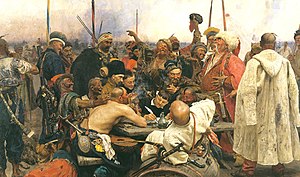Reply of the Zaporozhian Cossacks
From Wikipedia, the free encyclopedia

Ilya Repin, 1880-1891
canvas, 2.03 m × 3.58 m
State Russian Museum, St. Petersburg
Reply of the Zaporozhian Cossacks to Sultan Mehmed IV of the Ottoman Empire (also known as: Cossacks of Saporog Are Drafting a Manifesto - common international title, «Запорожцы пишут письмо турецкому султану» - common Russian title, «Запорожцы» - author's title) is a famous painting by the Russian artist Ilya Repin. The 3.58 m (11.74 ft) by 2.03 m (6.66 ft) canvas was started in 1880 and not finished until 1891. Repin recorded the years of work along the lower edge of the canvas. Alexander III bought the painting for 35,000 rubles, at the time the greatest sum ever paid for a Russian painting. Since then, the canvas has been exhibited in the State Russian Museum in Saint Petersburg.
Contents |
[edit] Context
Reply of the Zaporozhian Cossacks is a historical tableau, set in 1676, exploiting the legend of the reply that the Cossacks sent the Sultan of Ottoman Empire. The Cossacks of the Zaporozhian Host (from 'beyond the rapids', za porohamy), inhabiting the lands around the lower Dnieper River in Ukraine, had defeated Ottoman Turkish forces in battle. However, the Sultan of Ottoman Empire demanded that the Cossacks submit to Turkish rule. The Cossacks, led by Ivan Sirko, replied in an uncharacteristic manner: they wrote a letter, replete with insults and profanities. The painting exhibits the Cossacks' pleasure at striving to come up with ever more base vulgarities. During Repin's time, the Cossacks enjoyed great popular sympathy. Repin also admired them: "All that Gogol wrote about them is true! A holy people! No one in the world held so deeply freedom, equality, and fraternity."
The text of the Sultan's letter to the Cossacks:
-
As the Sultan; son of Muhammad; brother of the Sun and Moon; grandson and viceroy of God; ruler of the kingdoms of Macedonia, Babylon, Jerusalem, Upper and Lower Egypt; emperor of emperors; sovereign of sovereigns; extraordinary knight, never defeated; steadfast guardian of the tomb of Jesus Christ; trustee chosen by God himself; the hope and comfort of Muslims; confounder and great defender of Christians—I command you, the Zaporozhian Cossacks, to submit to me voluntarily and without any resistance, and to desist from troubling me with your attacks.
-
—Turkish Sultan Mehmed IV
According to the legend, the reply was a stream of invective and vulgar rhymes, parodying the Sultan's titles:
-
Zaporozhian Cossacks to the Turkish Sultan!
-
You, turkish devil and damned devil's brother and friend, secretary to Lucifer himself. What the devil kind of knight are you, that can't slay a hedgehog with your naked arse? The devil shits, and your army eats. You will not, you son of a bitch, make subjects of Christian sons; we've no fear of your army, by land and by sea we will battle with thee, fuck your mother.
-
You Babylonian scullion, Macedonian wheelwright, brewer of Jerusalem, goat-fucker of Alexandria, swineherd of Greater and Lesser Egypt, Armenian pig, Podolian villain, catamite of Tartary, hangman of Kamyanets, and fool of all the world and underworld, an idiot before God, grandson of the Serpent, and the crick in our dick. Pig's snout, mare's arse, slaughterhouse cur, unchristened brow, screw your own mother!
-
So the Zaporozhians declare, you lowlife. You won't even be herding Christian pigs. Now we'll conclude, for we don't know the date and don't own a calendar; the moon's in the sky, the year in the book, the day's the same over here as it is over there; for this kiss our arse!
-
Koshovyi Otaman Ivan Sirko, with the whole Zaporozhian Host
[edit] Original (Ukrainian)
-
Запорізькі козаки турецькому султану!
-
Ти – шайтан турецький, проклятого чорта брат i товариш і самого Люципера секретар! Який ти в чорта лицар коли голою сракою їжака не вб'єш? Чорт висирає а твоє вiйсько пожирає. Не будеш ти, сукин ти сину, синiв християнських пiд собою мати, твого вiйска ми не боїмося, землею i водою будем битися з тобою, распройоб твою мать.
-
Вавілонський ти кухар, Македонський колесник, Ієрусалимський бровирник, Олександрійський козолуп, Великого й Малого Єгипта свинар, Армянська свиня, Подолянська злодiюка, Татарський сагайдак, Каменецький кат, і всього світу і підсвіту блазень, а нашого Бога дурень, самого гаспида онук і нашого хуя крюк. Свиняча морда, кобиляча срака, різницька собака, нехрещений лоб, мать твою в'йоб!
-
Отак тобі козаки відказали плюгавче! Невгоден єсі матері вірних християн! Числа не знаєм бо календаря не маєм, місяць в небі, рік у книзі, а день такий у нас як і у вас, поцілуй за те у сраку нас!..
-
Пiдписали: Кошовий отаман Іван Сірко зо всім кошом запорізьким
[edit] Origins
The fact that this letter is not a true document of diplomacy of those times but a literary work has been demonstrated in numerous ways.
Firstly, the Cossacks never sent such documents to foreign countries in such a style. This can be seen in comparing archival materials of Cossack letters from various dates and content.
Secondly, had this document been true, various variants would not exist.
Thirdly, the variants have different dates (1600, 1619, 1620, 1667, 1696, 1713 and others)
Fourthly, there are different signatures under the letter: Otaman Zakharchenko, Ivan Sirko, the Nyz Cossacks etc.
Finally, each of the variants are addresses to different people: Osman, Ahmet II, Ahmet IV, Mahmud IV etc.
All this points to the document having a literary origin which was taken up in folk culture.
[edit] References
- Dmytro I. Yavornytsky (1895) History of the Zaporogian Cossacks, Vol. 2, pp. 517-518. St. Petersburg.
- Myron B. Kuropas (1961) The Saga of Ukraine: An Outline History. MUN Enterprises
[edit] External links
- Detailed analysis of the letter (archived version)
- History of the painting (Russian)
- Reply of the Zaporozhian Cossacks Outstanding Paintings, St. Peterburg, 1966. p.271 (Russian)

